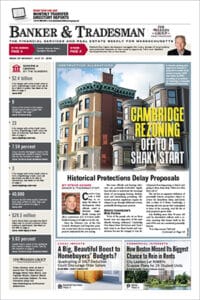In an effort to bring customers through their doors, many banks are dropping the old formality and taking tips from chains like The Gap and Burger King. Bank mergers and competition from other financial services firms has led many banks to revise their retail strategies.
The increased competition to provide financial services means that banks must rethink their operations and put customers first, said Kevin Kelly, executive vice president of Willey Bros. in Rochester, N.H.
“The trend very definitely is for banks to think more about their consumers,” Kelly said. “Unfortunately their business models don’t fit that well, so unless they change other things they have some difficulties in getting there.”
The consulting firm worked with Fleet Bank on a branch redesign in the mid-1990s, and is working with FleetBoston Financial to create a new retail look for the combined banks of Fleet and BankBoston.
“There’s an awful lot of experimentation right now in financial services of what the interior should look like,” Kelly said.
Companies may consider leasing space to Starbucks or to a dry cleaners to give people more reasons to come to the branch. Grocery stores and big box retailers like Wal-Mart have employed this approach, housing bank branches and McDonald’s restaurants.
“A lot of that trend is to try to make the bank more of a destination location,” Kelly said.
Citizens Bank spent $20 million in the last two years to update its retail branches, buy new technology and train employees in what it called the Citizens Millennium Project. The project included information kiosks to direct customers to the appropriate service areas. Branch employees received training to consult with customers and move to needs-based selling.
Commerce Bank of Cherry Hill, N.J., borrowed ideas from burger joints when it developed a new retail strategy. The $7 billion-asset bank describes its sales philosophy as a “have it your way” approach. The branches look alike from the inside and out, and are marked with giant letter C’s. The branches open at 7:30 a.m. on weekdays and stay open until 8 p.m., and include public restrooms.
While few banks have gone as far as Commerce Bank to break free of the traditional bank image, many have renovated their traditional, granite-filled buildings with vaults in the center to create glass storefronts and redesigned sales areas. When Willey Bros. worked with Fleet in the mid-1990s, it developed a consistent physical look for the bank’s branches, including a uniform color palette.
“What we’re doing right now is working with the FleetBoston group to visually brand all of the locations,” Kelly said. “What are the impressions you’re making to consumers? Are they the right impressions?”
Fleet faces the job of placing signs with the company’s new logo at each of its 5,750 retail outlets. The change is complicated by the fact that the Federal Trade Commission is requiring BankBoston and Fleet branches to keep their old signs for a month after the merger closed. In addition to hanging thousands of signs, the bank faces the challenge of making its branches have a similar appearance.
“A brand position must reflect and guide how a company goes to market – the character of its service, the particular expertise it offers, the messages it sends its customers,” said FleetBoston Executive Vice President Anne Finucane. “It can be a company’s most powerful marketing tool.”
Coordinated Strategy
In addition to its New Hampshire headquarters, Willey Bros. has offices in Chicago and Madrid, Spain, and an affiliate office in New York City. The company’s clients include H & R Block and Wells Fargo. For H & R Block, the firm designed retail outlets to market the company’s expanded line of financial services, including mortgages and investment services. The brightly colored offices, including a Massachusetts branch in Norwood, were designed to position the company as the USA Today of the financial services industry, setting it apart from more traditional firms.
While many banks have been trying to engage their customers more in the branches, their efforts may not succeed without a coordinated strategy, Kelly said.
“What happens a lot, unless banks have a thoughtful strategy, is that banks think that putting a bunch of posters up in their branch is going to engage their customers,” Kelly said. “Really, they’ve got to think about what the consumer’s doing, what the expectations are of the brand that they’re going to visit, how they think, what they do, and how they feel within the location.”
Of course, while banks rethink their retail strategies, they must consider what products they want to deliver to customers. Since the passage of the financial modernization bill made it easier for banks to offer insurance and investment products, many banks have marketed themselves as one-stop shopping financial centers.
However, studies have shown that consumers prefer to compare different brands before buying, Kelly said. Consumers often turn to the Internet to research products before buying them. Companies like E-loan serve as an intermediary. While E-loan does not make loans, it connects customers with more than 70 mortgage lenders, allowing them to comparison shop. At most bank Web sites, customers can buy only the products from that company.
“Consumers don’t want millions of choices, but they want enough choice where they can filter a couple of things,” Kelly said. “Banks have to really understand whether they’re going to distribute their products through intermediaries or whether they’re going to bring other products into their fold and make it more beneficial for customers.”
In the future, customers will demand access to their banks through a number of channels, including ATMs and the Internet, and will want each of those delivery channels to be connected, Kelly said.






